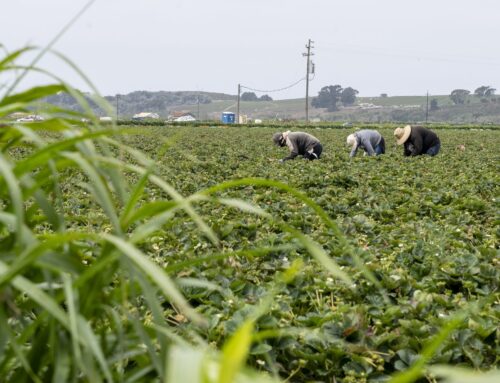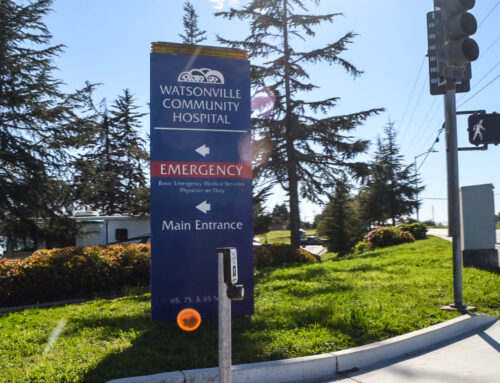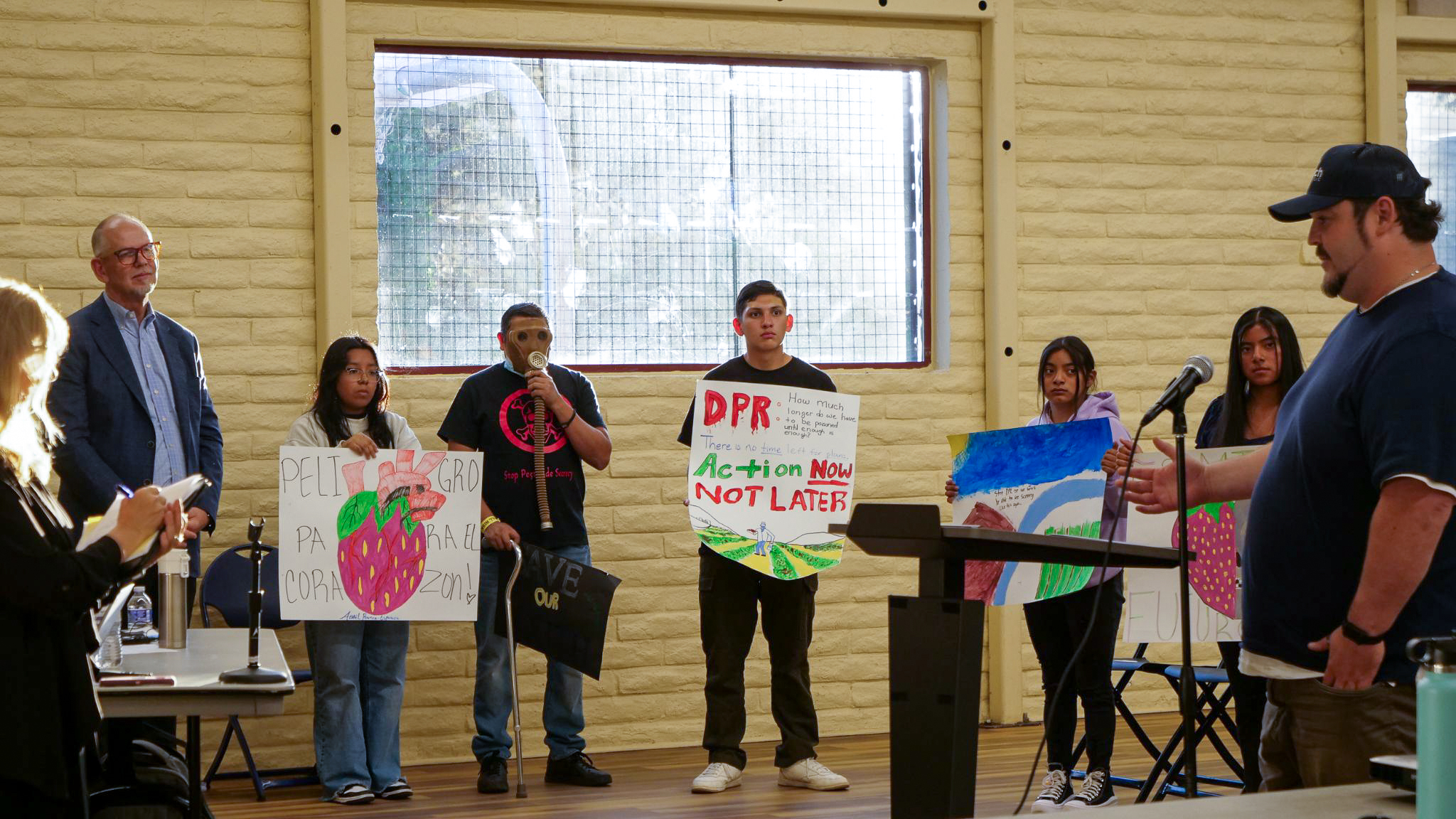
Youth activists from Safe Ag Safe Schools’ Future Leaders of Change attend a California Department of Pesticide Regulation meeting in Watsonville on Monday. (Andrea Tamayo — Santa Cruz Local)
WATSONVILLE >> At a meeting at Ramsay Park Family Center in Watsonville on Monday, some residents offered pointed input on the California Department of Pesticide Regulation’s draft Strategic Plan for 2024-2028.
Some key parts of the draft plan include more transparency about pesticide use, worker safety improvements and development of “sustainable pest management” that tries to reduce reliance on pesticides. Some critics, including nine students from Watsonville and Greenfield high schools, essentially said the plan was too vague and too slow to reduce health problems linked to pesticides.
“We need reform now. Because the children are the ones that are suffering,” said Ann López, director of Santa Cruz County-based Center for Farmworker Families, at the meeting.
Some children of farmworkers in Santa Cruz and Monterey counties have developed asthma, learning disabilities and cancer, López has said. “If you could see the suffering of the parents as their kids are afflicted with these things, it is absolutely tragic,” she said.
State officials are collecting feedback on the plan through Nov. 10, including at an online meeting on Friday, Nov. 3.
Many growers in Pajaro Valley rely on pesticides to prevent plant diseases, boost crop yields and control weeds. On berry fields, gaseous pesticides known as fumigants are injected into the soil. Plastic tarps usually prevent the gases from contaminating the air, although strong winds sometimes disrupt the tarps, state records show.
In 2017, there were 76 reported illnesses from agricultural pesticide exposure from farmworkers and pesticide applicators in Santa Cruz County, according to state regulators. From 2017 to 2022, pesticide use declined in part because of stricter Santa Cruz County regulations and some conversions to organic operations.
Pesticide regulation goals
State pesticide regulators have set a goal to eliminate the use of “priority pesticides” by transitioning to “sustainable pest management” practices by 2050. Sustainable pest management practices are “ecosystem based” and include habitat manipulation and resistant crop varieties, according to the pesticide regulation department.
One 2050 goal is to allow growers to use pesticides “only after monitoring indicates they are needed according to established guidelines, and treatments are made with the goal of removing only the target organism.” Another goal is to have growers apply pesticides in ways that minimize risks to human health and the environment.
Toward the 2050 aims, the pesticide regulation department’s draft Strategic Plan 2024-2028 lists four main goals and more than 50 smaller goals.
The four main goals in the draft plan are:
- Increased access to safe, effective and sustainable pest management. Plans include increasing grant funding for research, creating a diverse advisory board to guide prioritizing and implementing new practices, and creating a certification for produce grown sustainably.
- Tracked, evaluated and enforced pesticide use. Plans include improvements in data collection and tracking of pesticides in the air and water, increasing enforcement actions against repeat offenders and introducing policies to regulate pesticide sales.
- Increased engagement, collaboration and transparency with residents in agricultural areas. Plans include more outreach events, providing resources in multiple languages, and launching a statewide pesticide notification system.
- Increased collaboration with local, state, tribal and federal agencies.
Deadlines have not been set for any of the goals in the draft plan.
“The final strategic plan will include dates associated with all goals to track progress and increase accountability with the public on the department’s work,” wrote Leia Bailey, a spokesperson for the California Department of Pesticide Regulation, in an email.
Karen Morrison, chief deputy director and science advisor of the California Department of Pesticide Regulation, said the draft plan will aim the department toward the “mission and vision” of sustainable pest management.
“This is really intended to be what our action plan looks like for the coming five years,” Morrison said at the meeting. “We want to get more specific on what we’re accomplishing to have something concrete.”
Input on the draft plan
The plan proposes that the pesticide regulation department reduce the use of at least two “priority pesticides” per year. Priority pesticides have hazardous properties known to cause significant human or ecological harm. A priority pesticide could be a single ingredient, a pesticide or a group of related pesticides.
To eliminate the use of priority pesticides by 2050, state pesticide regulators published an Accelerating Sustainable Pest Management Roadmap in January. With input from an advisory committee that is expected to include growers, the pesticide regulation department plans to identify and list priority pesticides.
Because state pesticide regulators already listed 10 “priority” active ingredients in 2014 and 82 “high priority” active ingredients in 2011, advocates have said there is no need for a new list, according to a letter from Safe Ag Safe Schools’ Future Leaders of Change to state authorities. All 92 of those priority ingredients remained in use as of late March 2023 and await risk assessment from state pesticide regulators, according to Berkeley-based Californians for Pesticide Reform.
Bailey, of the state pesticide regulation department, said the department has done some risk assessments since the 2014 list was made. “The need to respond to emerging issues and new science has required and will continue to require ongoing reprioritization that may result in the scientific evaluation of some active ingredients ahead of those listed in previous prioritization documents,” Bailey wrote.
Some students from Future Leaders of Change also questioned why the advisory committee is expected to include “Big Ag and pesticide applicators.” The group wrote, “They shouldn’t be involved in a committee that is supposed to make decisions prioritizing public health rather than profits.”
Bailey said all stakeholders are involved “to achieve systemwide transition to sustainable pest management.”
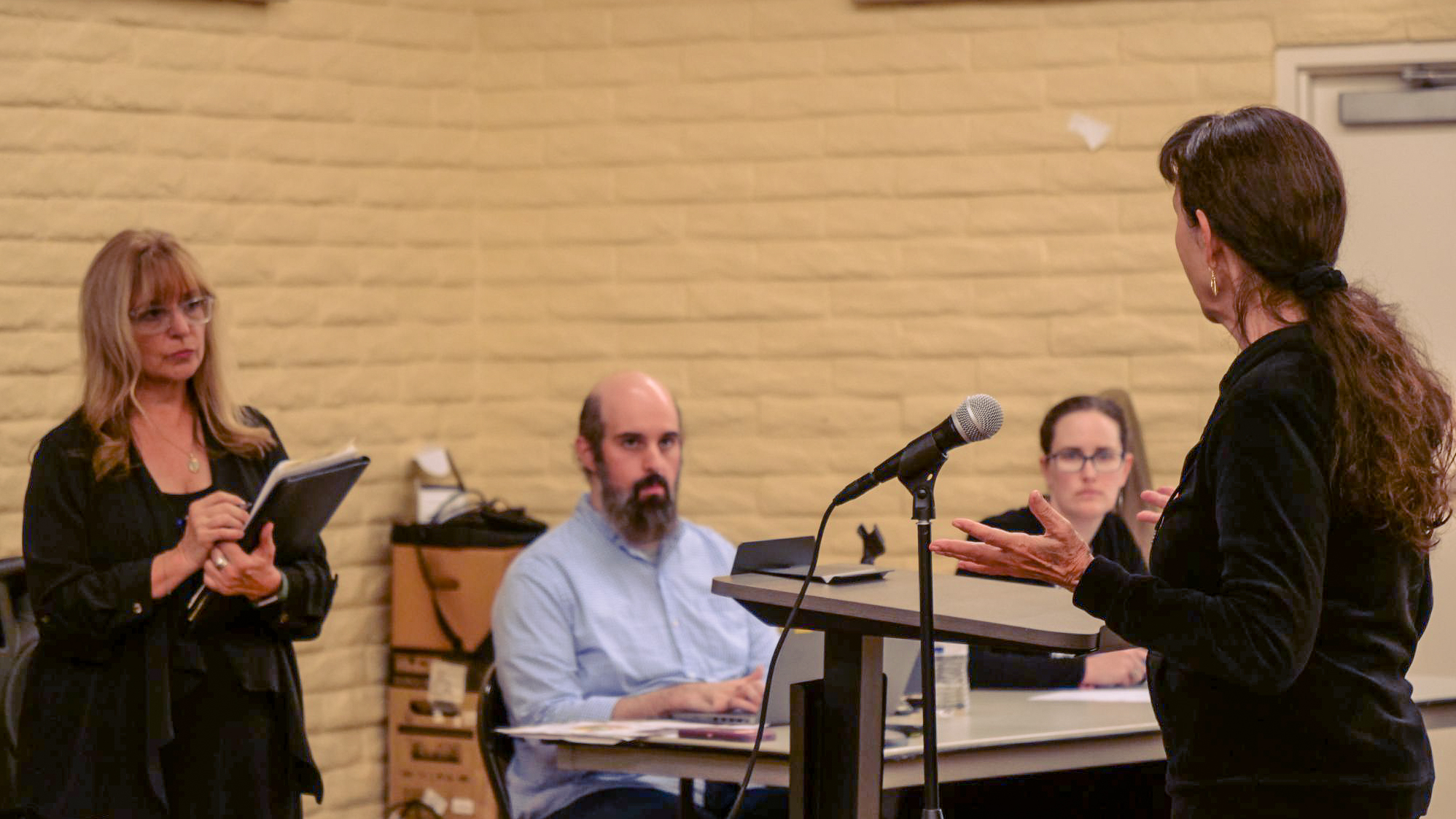
From left, Sherri Petro of VPI Strategies and David Mauss of the California Department of Pesticide Regulation listen to Ann López speak about health problems linked to pesticides at a meeting in Watsonville on Monday. López is the director of the Center for Farmworker Families. (Andrea Tamayo — Santa Cruz Local)
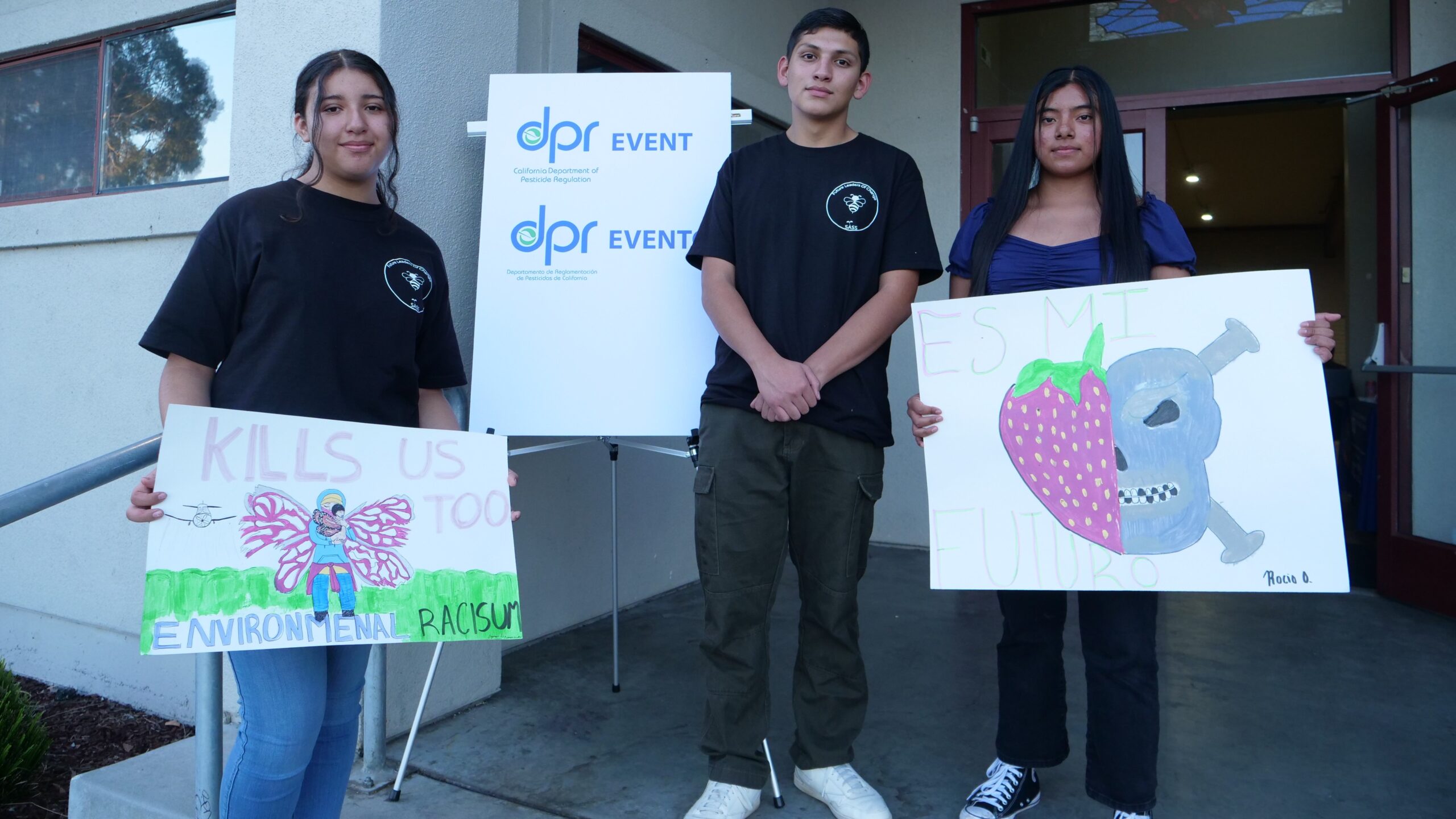
From left, Greenfield High School students Alexia Rangel, Victor Torres and Rocio Ortiz show signs they brought to a Department of Pesticide Regulation meeting at Ramsay Park in Watsonville on Oct. 30. (Andrea Tamayo — Santa Cruz Local)
Victor Torres, a senior at Greenfield High School, said the draft plan did not move toward reducing harm from pesticides. “Not only are they taking such little actions on how many pesticides they want to reduce, but they’re not even going to ban those pesticides,” Torres said. “They’re going to simply mitigate and research, which is not enough.”
Morrison, of the pesticide regulation department, at the end of the meeting recognized the calls for organic farming and health concerns about pesticides.
“We’ve heard comments about concerns around enforcement,” Morrison said. “But we’re still in the midst of public comment and we’re looking forward to hearing that over the course of the next week and a half.”
How to participate
State pesticide regulators will have two more public meetings before public comments on the draft 2024 Strategic Plan are due Nov. 10.
- 9:30 a.m. to noon Friday, Nov. 3 on Zoom.
- 4 to 6:30 p.m. Monday, Nov. 6 at the Meitzenheimer Community Center at 830 S. Blackstone St., Tulare.
Comments on the draft strategic plan will be accepted on the California Department of Pesticide Regulation website in English and Spanish until 5 p.m. Nov. 10. Comments also can be mailed to the California Department of Pesticide Regulation, 1001 I St., P.O. Box 4015, Sacramento, CA 95812-4015.
Read more
Questions or comments? Email [email protected]. Santa Cruz Local is supported by members, major donors, sponsors and grants for the general support of our newsroom. Our news judgments are made independently and not on the basis of donor support. Learn more about Santa Cruz Local and how we are funded.

Andrea Tamayo
Andrea Tamayo is a master's degree candidate in science communications at UC Santa Cruz. Tamayo holds degrees in microbiology and international studies from the University of Florida.


